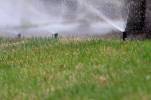Trees can ‘drink’ as much as lawns
The first pears of the season are ready to be picked. The University of Nevada Cooperative Extension Master Gardeners Orchard in North Las Vegas, together with the Whole Foods located at 8855 W. Charleston Blvd. and Gilcrease Orchard, will be hosting a pear and apple festival Saturday from 9 a.m. to noon in the Whole Foods' parking lot.
Q: I live in a patio home community and have lots and lots of trees. After converting to xeriscape a couple of years ago, no one was "informed" enough to increase the watering of the trees to compensate for the lack of grass. The landscape committee is scheduled to do a walk around with the landscaper to determine which trees will have to be chopped down due to lack of watering. Will these trees come back or must they be removed?
A: This is a common dilemma in Las Vegas. The grass is removed from a fully mature landscape with trees and the trees begin to die back. Landscapers who do this type of work are ill-informed about how much water trees will require once the grass is removed. Also, the tree roots are everywhere in the grass competing for the water applied to the lawn.
There are a number of qualified arborists who can make determinations about whether the trees need to be removed or not. Much of this has to do with how much of the tree has been damaged, the type of tree, the relative quality of that tree species and other issues.
Because lawns are considered the common enemy when it comes to water conservation they are singled out to be removed without much regard to other plants in the landscape. It is a common misconception that large trees do not consume as much water as lawns. Of course it depends on the type and size of the tree, but large trees can consume extremely large quantities of water -- in some cases more than a lawn the same size as the tree's canopy.
It is also a misconception that as trees get larger and become more mature, they consume less water. This is far from the truth. A very simple rule can help people make decisions when selecting woody landscape plants for desert landscapes; large trees use more water than small trees. Two mature Southern live oak trees will consume more water than 1,800 square feet of Bermuda grass grown as a lawn.
In my opinion, large trees have no role in residential urban landscapes, particularly in the desert, and should not be planted there. Likewise, lawns that are planted in the desert simply to be looked upon and serve no function other than aesthetic should not be planted either.
This makes a great segue to encourage interested citizens to attend our Landscape Design With the Desert in Mind series of classes that start the first week of September. These classes will teach you basics of landscape design to conserve energy and water in our desert environment. For more information about this class, call our master gardener help line at 257-5555.
Bob Morris is an associate professor with the University of Nevada Cooperative Extension. Direct gardening questions to the master gardener hot line at 257-5555 or contact Morris by e-mail at morrisr@unce.unr.edu.























